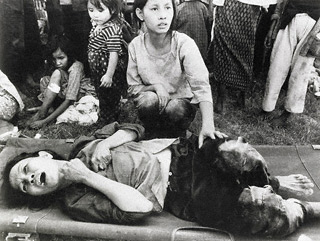• What do you notice first as you look at this image? What can you tell about this woman by looking closely at her face, hands, and feet?
• The woman in the foreground is suffering from shell shock. Merriam Webster Online Dictionary defines shell shock as: "post-traumatic stress disorder in soldiers as a result of combat experience." If shell shock is defined as a "post-traumatic stress disorder in soldiers," who is affected by it in this image?
• Look at the other figures in this image. What can you tell about them? How do you know? What is each of them reacting to?
• What has the photographer captured in this photograph? (In this photo, Gluck attempted to capture the effect of the war on the people caught in the crossfire.)
• What do images such as this communicate about the Vietnam War to us today?
• Compare this image with images from the newspapers of the war in Iraq today or other military conflicts. Discuss how these images are similar or different.
|
Timeline: The Vietnam War [RTF download - 191KB]
"These devastated people had just come out of the siege of An Loc....My attempt was simply to document the pain on the periphery of the war. It was about capturing that decisive moment when everything is revealed."
When Barbara Gluck captured this image she revealed the human side of war and its devastating effects. The woman on the stretcher looks to be in severe pain, but it is not exactly clear what she suffers from. She is being comforted by a teenage girl who looks distracted by something in the crowd around her. The woman is suffering from "shell shock," a nervous or mental disorder formerly believed to have been brought on by exploding shells in battle. It is now known as "post-traumatic stress disorder," the cumulative emotional effect brought on by the stresses of war.
As the United States reduced its military presence in Vietnam after eight years in the country, Communist forces launched another major attack on the south. The massive invasion, known as the Easter Offensive, began in March 1972. Located about 60 miles north of Saigon, the town of An Loc was under siege for more than two months before American air support caused the withdrawal of North Vietnamese forces from the region. As many as 1,000 shells rained down on the city each day, and without U.S. air support the city would have fallen into the North Vietnamese hands. Barbara Gluck covered the siege on assignment for The New York Times, capturing this image of a shell-shocked woman.
About the Artist
Barbara Gluck was born in 1938 and raised in New York City. She graduated from New York University with a BA in journalism and pursued a career in magazine advertising. In April 1968, Gluck was invited to travel for three weeks in Southeast Asia. While there she began taking photos and selling her work to the The New York Times, the Associated Press, and Newsweek. In January 1972, The New York Times sent Gluck and her husband, Joseph Treaster, as a team to Vietnam, and the couple covered the war until November 1973.
Gluck's remarkable accomplishments were widely recognized at the time this photo was made. She photographed the crew on board a 14-hour B-52 bombing mission, and she was also the only photographer and woman to spend 24 hours with the Vietcong. In 1973, the World Press Photo Foundation honored her with the award of Outstanding News Photo of the year for her work in Vietnam. In 1974, she received the Poynter fellowship from Yale University for excellence in journalism. Recently, Gluck returned to Vietnam to visit the sites she photographed during the war and see the changes that have come to a land that was destroyed by fighting only three decades ago.
|

